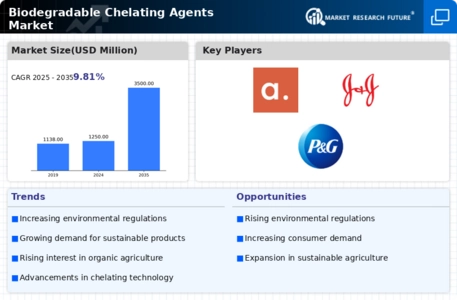Market Trends
Key Emerging Trends in the Biodegradable Chelating Agents Market
The biodegradable cheating agents market is presently observing significant trends that reflect shifts in demand and applications, primarily in the cleaning, agriculture, and water treatment industries. Biodegradable chelating agents play a vital role in preventing undesirable reactions when complexing metal ions during various processes. Another major trend observed in the market is the rising demand for eco-friendly cleaning products based on environmentally friendly, safe cleaners that do not contain harmful chemicals, particularly when using these types of products at home or around children. Furthermore, there is a strong influence from the agricultural sector, which shapes trends within this niche, considering that there is a growing trend towards sustainable farming practices as well as environmentally friendly agrochemicals, which has contributed to increased use of chelates in fertilizers and plant nutrition products alike. The usefulness of biodegradable chelates includes improved nutrient availability to plants, better fertilizer use efficiency, and reduced environmental runoff. This shift aligns with an emphasis by the agriculture industry on increasing yields while minimizing farming-related pollution. Technological advancements are also driving trends within the biodegradable chelates market. Biological enzyme formulations continue to gain prominence over other bio-organic products with more focus today being on biodegradable chelates in different industries. The biodegradable chelating agents market is also experiencing an increase in the number of collaborations and partnerships between companies. Through these collaborations, such firms aim to develop and explore innovative applications and formulations for their biodegradable chelates. Thus, some of these partnerships focus on addressing specific challenges within various sectors, such as consumer goods, food processing, or even water treatment. In this way, they are able to achieve continuous improvement as well as customization of biodegradable chelating agents to meet emerging needs in diverse sectors. The water treatment industry is another driver of trends in the field of biodegradable chelating agents. Such agents are used during water treatment processes to control metal ions and prevent scaling and corrosion. Additionally, greater emphasis on sustainable water management practices has necessitated the demand for environmentally friendly alternatives that can still treat water with great efficiency without causing any environmental harm. What's more, regulatory considerations form an important constituent of drivers influencing trends in the market for biodegradable chelating agents. The industry is subject to regulations and guidelines related to biodegradability, toxicity, and safety. As far as the current trend towards eco-friendly products is concerned, which are purchased instead of replacing non-decomposable items like those made from hard rubber or plastic, consumers are opting for decomposable versions over traditional ones. Consequently, most consumer goods produced nowadays incorporate degradable chelate into them, following a global shift towards eco-friendly sustainable products. Lastly, there has been an increased focus on hygiene and sanitation due to the global health crisis leading to heightened interest in bio-degradable Chellates during this period.






Leave a Comment